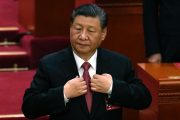
A recent comprehensive study revealed that China is developing an invisible arsenal of advanced and covert weaponry using next-generation technologies, particularly nanotechnology platforms, to provide the Chinese Communist Party (CCP) with warfare options on target populations.
According to the report, the invisible arsenal will provide the Chinese military with a range of warfare options, “including the delivery of biological, biochemical and neurobiological weapons” on target populations. These sophisticated weapons are “designed to be discreet, hard to detect, and capable of inflicting significant damage on adversaries while avoiding direct confrontation,” presenting “new challenges to global security that are without historical precedent in human history.”
The report, titled In the Shadows of Science: Unravelling China’s Invisible Arsenals of Nanoweapons, was published this month by the CCP BioThreats Initiative (CCP BTI), which is “dedicated to understanding and addressing the multifaceted challenges posed by the convergence of biotechnology, neurobiology, artificial intelligence, and human-computer interfaces.”
CCP BTI explained in the study that “nanotechnology-enabled weapons utilize highly sophisticated nanomaterials to enhance performance, stealth capabilities, and overall attack efficacy in military applications,” and that “China’s advancements in biotechnology raise concerns about potential dual-use applications, as there are fears they may be exploring genetically engineered pathogens for use in biological warfare, while obfuscating the original point of origins.”
The report warned that if China had a “stockpile of chemical warfare agents, coupled with advancements in nanotechnology,” they would be able to create “advanced nano-enhanced stealth chemical weapons. Furthermore, their expertise in electromagnetic and cyber warfare allows them to disrupt critical infrastructure and defense networks without direct military engagement, making traditional countermeasures obsolete and ineffective.”
Adding to China’s invisible arsenal is their development in hypersonic technology and AI-driven warfare capabilities, which could deliver these weapons with “unprecedented speed and precision, further complicating defense strategies.”
The study listed the potential threats of nanotechnology warfare if China were to “develop new invisible arsenals beyond traditional chemical and biological weapons.” These potential invisible threats include:
• Nanoscale Electronics and Cyber Warfare: Nanotechnology can enable the development of miniature, high-performance electronic components, and sensors … that could lead to the creation of advanced, undetectable nano-devices for surveillance, data theft, or even disrupting critical infrastructure without leaving a trace.
• Nano-Enhanced Stealth Materials: Nanomaterials can be engineered to manipulate light and electromagnetic waves, potentially leading to the creation of advanced stealth materials.
• Nanomedicine as a Weapon: While nanomedicine holds great promise for medical advancements, it could also be misused as a weapon.
• Nanorobotics and Autonomous Weapons: Nanotechnology can facilitate the development of nanorobots with various functions, such as swarm intelligence and autonomous decision-making.
• Nano-Bioinformatics for Biowarfare: Advanced computational techniques, combined with nanotechnology, could allow for the manipulation of biological data and the creation of synthetic pathogens or genetically modified organisms with enhanced virulence or drug resistance.
• Nano-Scale Chemical Sensors: Nanosensors can be used for detecting and identifying chemical substances at extremely low concentrations, making them ideal for covert monitoring or assessing the success of chemical attacks.
• Nano-Cyber Biological Weapons: The integration of nanotechnology with cyber and biological domains could give rise to sophisticated hybrid weapons, where nanoscale devices are deployed to infect computer systems, disrupt communication networks, or control biological agents remotely.
• Nanoparticle-Enhanced Energy Weapons: Nanoparticles could be employed to enhance the performance of directed energy weapons, such as laser systems or electromagnetic pulse (EMP) devices, enabling more precise and devastating attacks.
The report shared the above potential threats as examples to illustrate “the combination of nanotechnology with various fields,” which would introduce “novel and complex challenges for security and non-proliferation efforts.”
One risk that the report associated with the advancement of potential applications in biosensing, bioimaging, and drug delivery was the “ability of nanorobots to transport biological agents directly to target cells with deadly precision.” This could then be “exploited by the CCP’s People’s Liberation Army (PLA) for harmful purposes.”
In conclusion, the CCP BTI warned that any breakthrough in these potential nanotechnologies “would provide unprecedented tools for the CCP to forcibly establish a new world order, which has been Xi Jinping’s lifelong goal.”
To safeguard against these invisible weapons, the report stated the need to invest “in new detection technologies, leveraging AI and machine learning, fostering international collaboration, and updating arms control agreements [so that] the global community can enhance its ability to detect and mitigate the dangers of these new and emerging threats.”
LJ Eads, Xiaoxu Sean Lin, and Dr. Ryan Clarke, the founders of CCP BTI and the authors of this report, have expertise in microbiology, immunology, biodefense, and intelligence. They have published a number of articles in line with their mission to focus “on potential threats under the jurisdiction of various global actors, with an emphasis on programs associated with the Chinese Communist Party and its affiliated entities, such as the People’s Liberation Army, the United Front, and the Ministry of State Security.”




